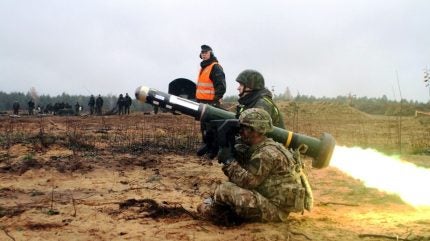
A new shipment of US-manufactured, medium-range Javelin anti-tank systems was handed over to the Lithuanian Armed Forces this week.
Amounting to $16.6m, these systems will be assigned to Lithuania’s Land Force units.
Javelin is a man-portable, anti-tank weapon developed by a joint venture comprising defence companies Raytheon and Lockheed Martin. It is shoulder-fired but can also be deployed from multiple platforms installed on tracked, wheeled or amphibious vehicles.
It has been deployed extensively for combat missions in the counter-insurgency wars in Afghanistan and Iraq. The US and coalition forces have conducted more than 5,000 engagements with the weapon system in these two countries alone.
However, Javelin is also being widely used by the Ukrainian army against Russian tanks and armoured vehicles during the ongoing Russo-Ukrainian war. As part of the US’ military assistance to Ukraine – now worth $50.6bn (Hrv2trn) since the Russian invasion began just over two years ago – the donor has provided more than 10,000 Javelin systems as of 10 May 2024, according to the US Department of Defense.
A newfound respect for the Javelin
“Beyond doubt, the Javelin anti-tank system the United States has made available for Lithuania to acquire is a boost to the Lithuanian Armed Forces’ combat capacity and deterrent effect,” said Lithuania’s Minister of National Defence Laurynas Kasčiūnas.
Demand for the Javelin has actually increased, even after 30 years of service. Whether used in counter-insurgency missions or in a peer-on-peer context, the system continues to be extremely useful in the current form of warfare in eastern Europe.
Speaking with Army Technology, GlobalData Defence Analyst Tristan Sauer pointed out that these systems, while largely unchanged for some time, have a newfound value in Ukraine.
“This is a capability that was previously undervalued or under-appreciated, because the focus on counter-insurgency operations meant that there was not as much of a risk of encountering enemy armoured vehicles or platforms.
“Ukraine started off using Javelins, Carl Gustaf rocket launchers, Stingers – and all of these were built in the 1980s. So there has been little-to-no innovation in this space,” Sauer pointed out.
“What we learn from Ukraine is that even with the innovations that the Russians put into armoured vehicles, and they were always considered to be very forward thinking and relatively advanced, it has been proven that even without innovating in the man-portable heavy weapons space, those things are still extremely lethal, extremely useful against modern armoured platforms.”




